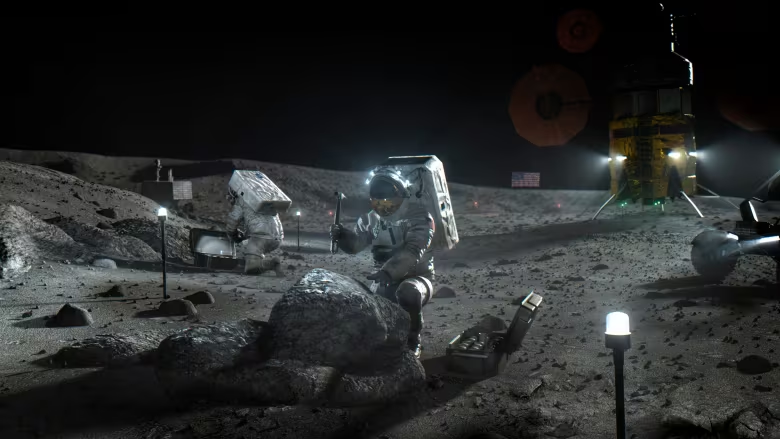Space mining, once the realm of science fiction, is rapidly becoming a feasible prospect with advancements in space exploration and resource utilization technologies. The concept involves extracting valuable resources, such as metals, water, and rare minerals, from asteroids and other celestial bodies to meet Earth’s growing demand for natural resources and support future space missions. This blog explores the potential of space mining, technological challenges, practical applications, and its implications for space exploration and sustainable resource management.
Understanding Space Mining
Space mining refers to the extraction and processing of minerals and resources from asteroids, moons, or other celestial bodies. Asteroids, in particular, are rich in metals like iron, nickel, cobalt, and platinum-group elements, which are valuable for manufacturing and space infrastructure development. Water ice found in asteroids can be used for life support systems, fuel production, and as a potential resource for future human colonization efforts.
Technological Challenges and Solutions
- Asteroid Prospecting:
Identifying suitable asteroids and characterizing their composition from Earth or nearby spacecraft requires advanced remote sensing technologies, spectroscopy, and imaging systems. Prospecting missions like NASA’s OSIRIS-REx and Japan’s Hayabusa2 demonstrate the feasibility of studying asteroid composition and mineralogy. - Mining Techniques:
Developing mining techniques tailored for microgravity environments presents unique challenges. Concepts include drilling, excavation, and regolith processing to extract and refine resources efficiently. Autonomous robotics and AI-controlled systems are envisioned for performing these tasks autonomously. - Resource Extraction and Processing:
Processing mined materials in space involves refining ores into usable metals and extracting water from ice deposits. Technologies such as in-situ resource utilization (ISRU), 3D printing, and additive manufacturing enable on-site production of tools, spare parts, and infrastructure components. - Transport and Logistics:
Efficient transportation of mined resources back to Earth or to space habitats requires innovative propulsion systems, such as solar-electric propulsion or resource-efficient chemical propulsion. Asteroid capture and orbital transfer techniques are under development for transporting large payloads.
Practical Applications of Space Mining
- Resource Sustainability:
Space mining offers a sustainable alternative to terrestrial mining by reducing environmental impact and preserving Earth’s natural resources. Accessing asteroid resources could alleviate supply shortages of critical metals and minerals on Earth. - Space Infrastructure Development:
Mined metals and materials can be used to construct space habitats, spacecraft components, solar arrays, and radiation shielding. These resources support long-duration space missions and enable the establishment of permanent human settlements beyond Earth. - Fuel Production and Propellant Refueling:
Water extracted from asteroids can be split into hydrogen and oxygen through electrolysis, creating propellants for spacecraft and fueling stations in space. This “space fueling economy” supports extended missions, satellite servicing, and interplanetary travel. - Scientific Exploration and Research:
Studying asteroid composition provides insights into the early solar system’s formation and evolution. Sample return missions and robotic exploration of asteroids contribute to planetary science and astrobiology research.
Challenges and Considerations
- Regulatory and Legal Frameworks:
Establishing international agreements and regulatory frameworks for space mining activities, property rights, environmental protection, and responsible resource utilization is essential to prevent conflict and ensure equitable access to space resources. - Economic Viability:
Assessing the economic feasibility of space mining ventures requires cost-effective technologies, market demand for extracted resources, and sustainable business models. Initial investments in research, development, and infrastructure are substantial. - Space Debris and Collision Risks:
Mitigating collision risks between spacecraft and asteroids, managing space debris, and ensuring orbital safety are critical for mission success and spacecraft longevity. - Public Perception and Ethical Considerations:
Addressing public concerns about space resource exploitation, environmental impact, and ethical implications of altering celestial bodies requires transparent communication, ethical guidelines, and stakeholder engagement.
Future Outlook
Space mining represents a paradigm shift in humanity’s approach to resource utilization and space exploration. As technological capabilities continue to advance and international collaboration expands, space mining holds the potential to unlock vast reserves of resources beyond Earth’s boundaries. The integration of space mining with sustainable development goals, environmental stewardship, and exploration of the cosmos underscores its role in shaping the future of space exploration and expanding humanity’s presence in the solar system. Embracing the challenges and opportunities of space mining paves the way for a new era of innovation, discovery, and sustainable resource management in outer space.
From Our Editorial Team
Our Editorial team comprises of over 15 highly motivated bunch of individuals, who work tirelessly to get the most sought after curated content for our subscribers.



